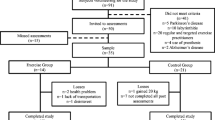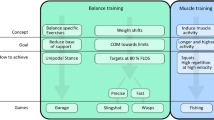Abstract
Background and aims: Programs designed to improve balance in older adults may function by improving general fitness (strength, endurance, range of motion) and also changing the attentional demands of postural control. Research in previously sedentary older adults cannot differentiate between changes in balance ability resulting from improved fitness or reduced attentional demands. A training program of games-based balance biofeedback was given to nine older adults with previous exercise experience. Methods: Training consisted of sixteen sessions (twice weekly for eight weeks) of 30 minutes each. Postural sway (force plate measurement), attentional demands (dual task paradigm), the Community Balance and Mobility Scale (CB&M), and the six minute walk test were measured in pre, post and retention tests. Results: Participants in the training group significantly decreased their reaction time from pre to post testing in a dual task paradigm compared to a control group. The training group also significantly increased their scores on the CB&M scale compared to control participants. The decreased reaction times and increased CB&M scores observed in the training group were maintained through a two week retention period. Changes in reaction time were significantly correlated with changes in CB&M score. Six minute walk distance increased significantly in both groups and did not appear to result directly from the training program. Conclusions: Gamesbased balance biofeedback training using a range of training postures can significantly improve functional balance in exercise trained older adults by reducing the attentional demands of postural control.
Similar content being viewed by others
References
Rubenstein LZ. Falls in older people: epidemiology, risk factors and strategies for prevention. Age Ageing 2006; 35 (S2): 37–41.
American Geriatrics Society, British Geriatrics Society, and American Academy of Orthopaedic Surgeons Panel on Falls Prevention. Guideline for the prevention of falls in older persons. J Am Geriatr Soc 2001; 49: 664–72.
Spriduso WW, Cronin DL. Exercise dose-response effects on quality of life and independent living in older adults. Med Sci Sports Exerc 2001; 33: s598–608.
Carter ND, Kannus P, Khan KM. Exercise in the prevention of falls in older people. Sports Med 2001; 31: 427–38.
Howe T, Rochester L, Jackson A, et al. Exercise for improving balance in older people. Cochrane Database Syst Rev 2007; 4.
Balasubramaniam R, Wing AM. The dynamics of standing balance. Trends Cogn Sci 2002; 6: 531–6.
Woollacott M, Shumway-Cook A. Attention and the control of posture and gait: A review of an emerging area of research. Gait Posture 2001; 16: 1–14.
Lajoie Y, Teasdale N, Bard C, Fleury M. Attentional demands for static and dynamic equilibrium. Exp Brain Res 1993; 97: 139–44.
Teasdale N, Simoneau M. Attentional demands for postural control: The effects of aging and sensory reintegration. Gait Posture 2001; 14: 203–10.
Lajoie Y. Effect of computerized feedback postural training on posture and attentional demands in older adults. Aging Clin Exp Res 2004; 16: 1–6.
Bisson E, Contant B, Sveistrup H, Lajoie Y. Functional balance and dual-task reaction times in older adults are improved by virtual reality and biofeedback training. Cyberpsychol Behav 2007; 10: 16–23.
Fraizer EV, Mitra S. Methodological and interpretive issues in posture- cognition dual-tasking in upright stance. Gait Posture 2008; 27: 271–9.
Quant S, Adkin AL, Staines WR, Maki BE, McIlroy WE. The effect of a concurrent cognitive task on cortical potentials evoked by unpredictable balance perturbations. BMC Neurosci 2004; 5: 1–12.
Herndon A, Decambre M, McKenna P. Interactive computer games for treatment of pelvic floor dysfunction. J Urol 2001; 166: 1893–8.
Wolf SL, Barnhart HX, Kutner NG, McNeely E, Coogler C, Xu T. Reducing frailty and falls in older persons: An investigation of tai chi and computerized balance training. J Am Geriatr Soc 1996; 44: 489–97.
Rubenstein LZ, Josephson K, Trueblood P et al. Effects of a group exercise program on strength, mobility, and falls among fallprone elderly men. J Gerontol A Biol Sci Med Sci 2000; 55: 317–21.
Baker MK, Kennedy DJ, Bohle PL et al. Efficacy and feasibility of a novel tri-modal robust exercise prescription in a retirement community: a randomized, controlled trial. J Am Geriatr Soc 2007; 55: 1–10.
Howe JA, Inness EL, Venturi A, Williams JI, Verrier MC. The community balance and mobility scale — a balance measure for individuals with traumatic brain injury. Clin Rehabil 2006; 20: 885–95.
Bautmans I, Lambert M, Mets T. The six-minute walk test in community dwelling elderly: influence of health status. BMC Geriatr 2004; 4: 6.
Waddington GS, Adams RD. The effect of a 5-week wobble-board exercise intervention on ability to discriminate different degrees of ankle inversion, barefoot and wearing shoes: A study in healthy elderly. J Am Geriatr Soc 2004; 52: 573–6.
Maki BE, Zecevic A, Bateni H, Kirshenbaum N, McIlroy WE. Cognitive demands of executing postural reactions: Does aging impede attention switching? NeuroReport 2001; 12: 3583–7.
Maylor EA, Allison S, Wing AM. Effects of spatial and nonspatial cognitive activity on postural stability. Br J Psychol 2001; 92: 319–38.
Latham N, Bennett D, Stretton C, Anderson C. Systematic review of progressive resistance strength training in older adults. J Gerontol A Biol Sci Med Sci 2004; 59: 48–61.
Author information
Authors and Affiliations
Corresponding author
Additional information
Redundant or duplicate publication: A portion of this work was presented in poster format at the Virtual Rehabilitation 2009 International Conference in Haifa, Israel; Heiden E, Lajoie Y, Nativ A. Games-based biofeedback training — applications in rehabilitation and fall prevention. IEEE: Virtual Rehabilitation International Conference 2009, p. 215.
Rights and permissions
About this article
Cite this article
Heiden, E., Lajoie, Y. Games-based biofeedback training and the attentional demands of balance in older adults. Aging Clin Exp Res 22, 367–373 (2010). https://doi.org/10.1007/BF03337732
Received:
Accepted:
Published:
Issue Date:
DOI: https://doi.org/10.1007/BF03337732




